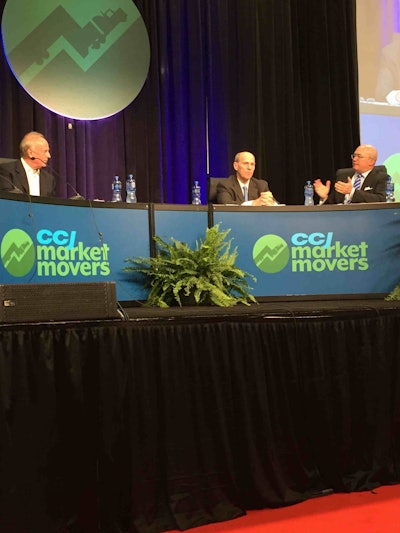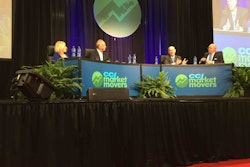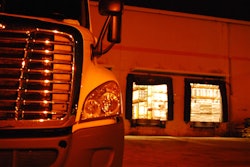 Panelists from left: Alain Bedard, chairman and CEO of Transforce; David Parker, president of Covenant Transportation Group; and Donald Broughton, economist from Avondale Partners.
Panelists from left: Alain Bedard, chairman and CEO of Transforce; David Parker, president of Covenant Transportation Group; and Donald Broughton, economist from Avondale Partners.Trucking companies involved in e-commerce can look forward to “multiple years of tremendous growth,” predicts Covenant Transportation Group President David Parker, due in large part to millennial consumers who want to shop online and have their purchases delivered promptly. What’s being referred to as the “Amazon effect” has driven U.S. e-commerce up 15 percent annually in recent years, compared to a mere 2 percent for traditional retail. And Parker doesn’t see things slowing down any time soon. “There is a long runway” on e-commerce, he says, “with a lot of room to grow.”
Today, e-commerce makes up 35 percent of CTG’s total revenue, made possible by one of the largest team fleets in the U.S. “We’ve been in the expedited business since we started but e-commerce has changed it dramatically in the last few years,” Parker says.
Parker’s remarks came during the CCJ Market Movers event, held Thursday, Aug. 25, 2016, at the Great American Trucking Show in Dallas. Moderated by Donald Broughton with Avondale Partners and Morgan Brennan of CNBC, the panel discussion also featured Alain Bedard, chairman and CEO of TransForce.
Bedard, too, sees a big future in growing his company’s e-commerce business, which went from “next to nothing,” to delivering 30,000-50,000 loads per day in last mile operation in the U.S. Bedard credits the shift to the company’s purchase of Dynamex, which specializes in same day services, five years ago. Between its last-mile operations and the next-day service it provides in Canada, TransForce saw its e-commerce business grow tremendously in the last five years, Bedard says.
The shift toward e-commerce has affected a lot of brick-and-mortar stores, who are finding it hard to compete with their Internet upstarts, causing stores like Macy’s and Sear’s to shutter locations. “That’s going to continue to develop,” Parker says, as traditional retailers look for ways to shift their business model. “Wal-Mart is not going to sit on the sidelines and let Amazon take it all,” he says. “They want to make sure they stay in the game.”
Another upstart technology with potential to disrupt trucking is Uber, the on-demand car service that has had a big impact on the taxi industry. Parker believes trucking is already “uberized.” “At the end of day, you’re posting trucks and looking for freight or posting freight and looking for trucks, whether through our brokerage or Truckstop.com,” he says. The biggest issue with Uber-like apps is safety, he says. Traditional brokers must make sure truckers have a good safety rating and the proper insurance. With Uber, “that hasn’t been thought through,” he says. “If it is successful I think it’s going to be a onesy-twosy type system.”
Taxis and trucking are not the same thing, Bedard says. “Trucking is lean and mean but also very capital intensive,” compared to the Uber model of a driver and a personal car, he says. Bedard does see potential for an Uber-type solution for last mile deliveries. “They are good in a short radius of 3-5 miles. But they cannot compete with a trucking company.”












